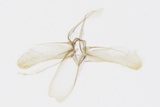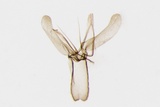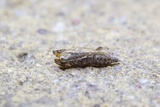Phyllonorycter roboris (Zeller, 1839) Species
Last modified: Dec. 10, 2025, 5:54 p.m.
A rather common species throughout Belgium
Details
- Classification
- Family: Gracillariidae > Subfamily: Lithocolletinae > Genus: Phyllonorycter > Species: Phyllonorycter roboris
- Vernacular names
- Bonte eikenvouwmot (NL), Gold-bent midget (EN), Marmorierte Eichen-Faltenminiermotte (DE)
- First mention in Belgium
- Fologne E. 1859b. Supplément au catalogue des lépidoptères de Belgique. — Annales de la Société entomologique belge 3: 133–142. On page 141 (Lithocolletis roboris. Zell.). view page
- Status
-
Native
Distribution
Imago
Head white with some scattered ochreous scales; forewing ground colour golden ochreous with an unmistakable pattern of white scales; a whitish patch in the basal ochreous field which is sharply edged with brown scales, a large white area in the middle of the wing; four costal and two dorsal striae, all situated very closely to the apical area; a small but conspicuous black dot in the apical area, from which a dark grey hook in the apical cilia arises.
Museum specimens
No pictures yet!Specimens in nature
No pictures yet!Mine
A large (ca. 20 mm), semi-circular or oval, tentiform mine on the underside of a leaf, mostly close to the leaf basis. Mostly much contorted. The underside of the mine with rather many, very fine longitudinal folds. The black frass is concentrated in one corner of the mine.
See also gracillariidae.net and bladmineerders.be.
Bionomics
The species hibernates in the pupal stage, among leaf litter on the ground. After emergence of the adult, the pupal skin protrudes from the mine.
Flight periods
Two generations a year from April towards August.
Observed on
- Host plant (species):
- Quercus robur, Quercus petraea and Quercus pubescens
- Host plant (genera):
- Quercus
The species is monophagous on Quercus, in Belgium mainly found on Quercus robur, but also recorded from Q. petraea and Q. pubescens.




